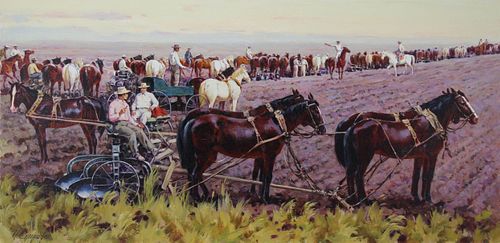Ivan Sushchenko (B. 1930) Harvesting in the West
Lot 431
Estimate:
$250 - $500
Absentee vs Live bid
Two ways to bid:
- Leave a max absentee bid and the platform will bid on your behalf up to your maximum bid during the live auction.
- Bid live during the auction and your bids will be submitted real-time to the auctioneer.
Bid Increments
| Price | Bid Increment |
|---|---|
| $0 | $10 |
| $100 | $25 |
| $250 | $50 |
| $1,000 | $100 |
| $2,500 | $250 |
| $7,500 | $500 |
| $20,000 | $1,000 |
| $50,000 | $2,500 |
| $100,000 | $5,000 |
| $250,000 | $10,000 |
About Auction
By Helmuth Stone Gallery
Jul 5, 2020
Set Reminder
2020-07-05 13:00:00
2020-07-05 13:00:00
America/New_York
Bidsquare
Bidsquare : July 5th Fine Art, Antique and Jewelry Auction
https://www.bidsquare.com/auctions/helmuth-stone-gallery/july-5th-fine-art-antique-and-jewelry-auction-5267
The July 5th Auction will feature Part II of the David Chang Snuff Bottle Collection, Important Chinese Porcelains from a private San Francisco California collection as well as original illustrations from the James A. Helzer Collection. Helmuth Stone Gallery helmuthstone@gmail.com
The July 5th Auction will feature Part II of the David Chang Snuff Bottle Collection, Important Chinese Porcelains from a private San Francisco California collection as well as original illustrations from the James A. Helzer Collection. Helmuth Stone Gallery helmuthstone@gmail.com
- Lot Description
Ivan Akimovich Sushchenko (Russian, B. 1930) "Harvesting in the West" Signed lower left. Original Oil painting on Masonite.
Provenance: Collection of James A. Helzer (1946-2008), Founder of Unicover Corporation.
This painting originally appeared on the Fleetwood First Day Cover of the $2 Harvesting in the West stamp issued June 18, 1998.
From the founding of the nation to the end of the 19th century, farming was the most important economic activity in the United States. The most efficient and productive in the world, American agriculture was blessed with many favorable conditions that contributed to this success. These included abundant fertile soil, moderate climate, ease of private land ownership, growth markets at home and abroad, and the constant development and refinement of farm machinery. Such technological innovations as the cotton gin, iron and steel plows, reapers, threshing machines, grain drills, corn planters, and iron harrows and cultivators transformed the West's vast prairies into the nation's granary. In the early 19th century, hundreds of thousands of farmers migrated west of the Mississippi River to the Great Plains and the Rocky Mountain and West Coast states to take advantage of the region's fertile lands. As a result, by 1860 America had over 2 million farms and agricultural products comprised 82 percent of the nation's exports. The Homestead Act, passed in May 1862, further encouraged westward growth by offering public land grants to small farmers. Within three years 15,000 homestead claims had been established. During the last three decades of the 19th century, the area of cultivated land in the U.S. more than doubled and crop production nearly tripled. The life of a farmer was never easy, however. Regular hardships included bitter cold, intense heat, floods, drought, Indian attacks and locusts.
Image Size: 10 x 20.25 in.
Overall Size: 12.5 x 22.75 in.
Unframed.
(B16008) - Shipping Info
-
Helmuth Stone Gallery recommends obtaining shipping quotes prior to bidding on any items in our auctions. (For international shipments buyer is responsible for all duties, customs, and taxes, which are NOT included in the shipping price. In adherence with federal shipping regulations, Helmuth Stone Gallery will not alter any invoices for shipping). If you are interested in obtaining an additional list of local shippers, please email us and we will send one over. • PakMail o 941-751-2070 o Paktara266@gmail.com
-
- Buyer's Premium



 EUR
EUR CAD
CAD AUD
AUD GBP
GBP MXN
MXN HKD
HKD CNY
CNY MYR
MYR SEK
SEK SGD
SGD CHF
CHF THB
THB














